Intercultural Management and Saudi Culture
VerifiedAdded on 2020/04/21
|16
|3257
|114
AI Summary
This assignment delves into the intricacies of intercultural management, specifically focusing on Saudi Arabian culture. It examines Hofstede's cultural dimensions and how they influence various aspects of business within Saudi Arabia. Students are encouraged to analyze case studies, research relevant literature, and apply theoretical concepts to understand the challenges and opportunities presented by managing across cultures in this specific context.
Contribute Materials
Your contribution can guide someone’s learning journey. Share your
documents today.
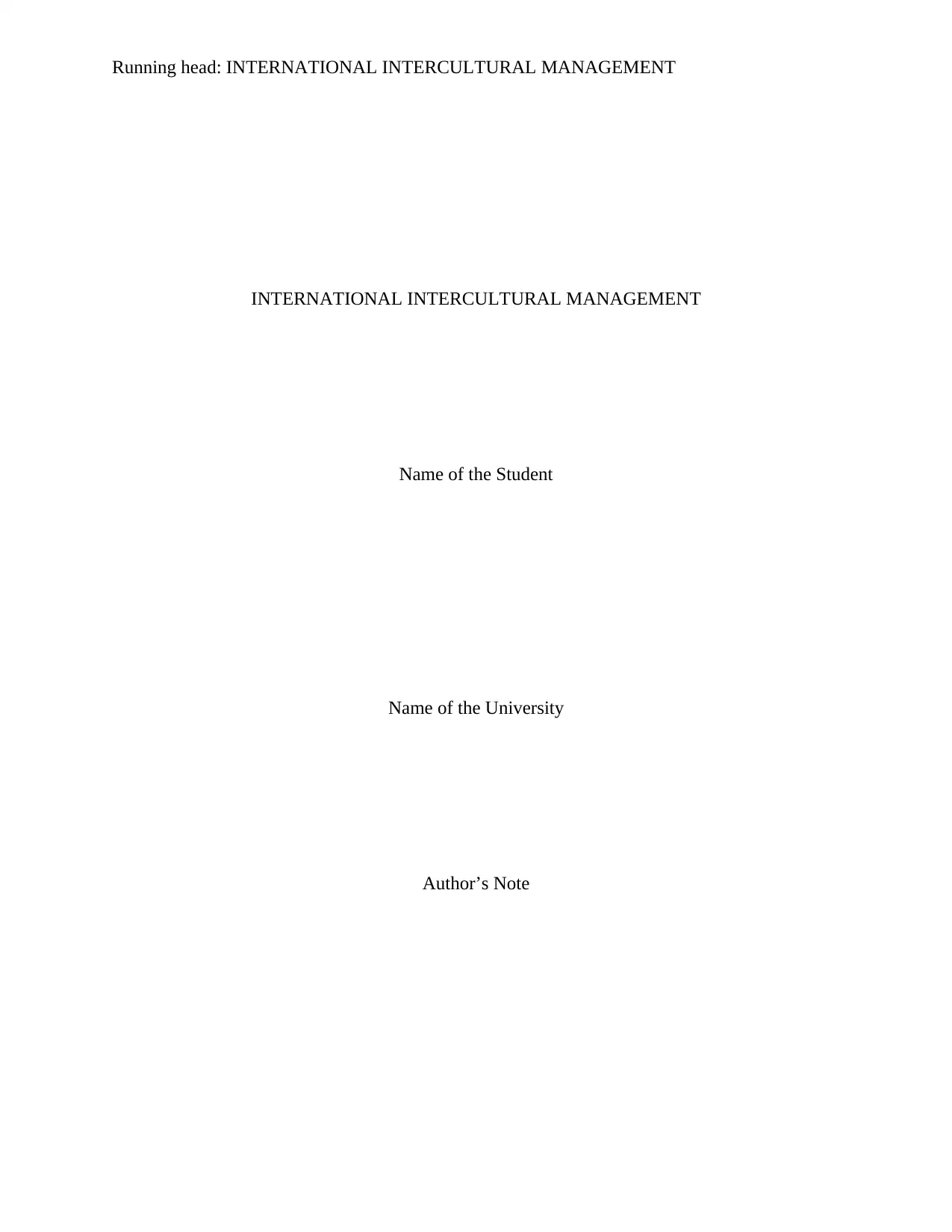
Running head: INTERNATIONAL INTERCULTURAL MANAGEMENT
INTERNATIONAL INTERCULTURAL MANAGEMENT
Name of the Student
Name of the University
Author’s Note
INTERNATIONAL INTERCULTURAL MANAGEMENT
Name of the Student
Name of the University
Author’s Note
Secure Best Marks with AI Grader
Need help grading? Try our AI Grader for instant feedback on your assignments.
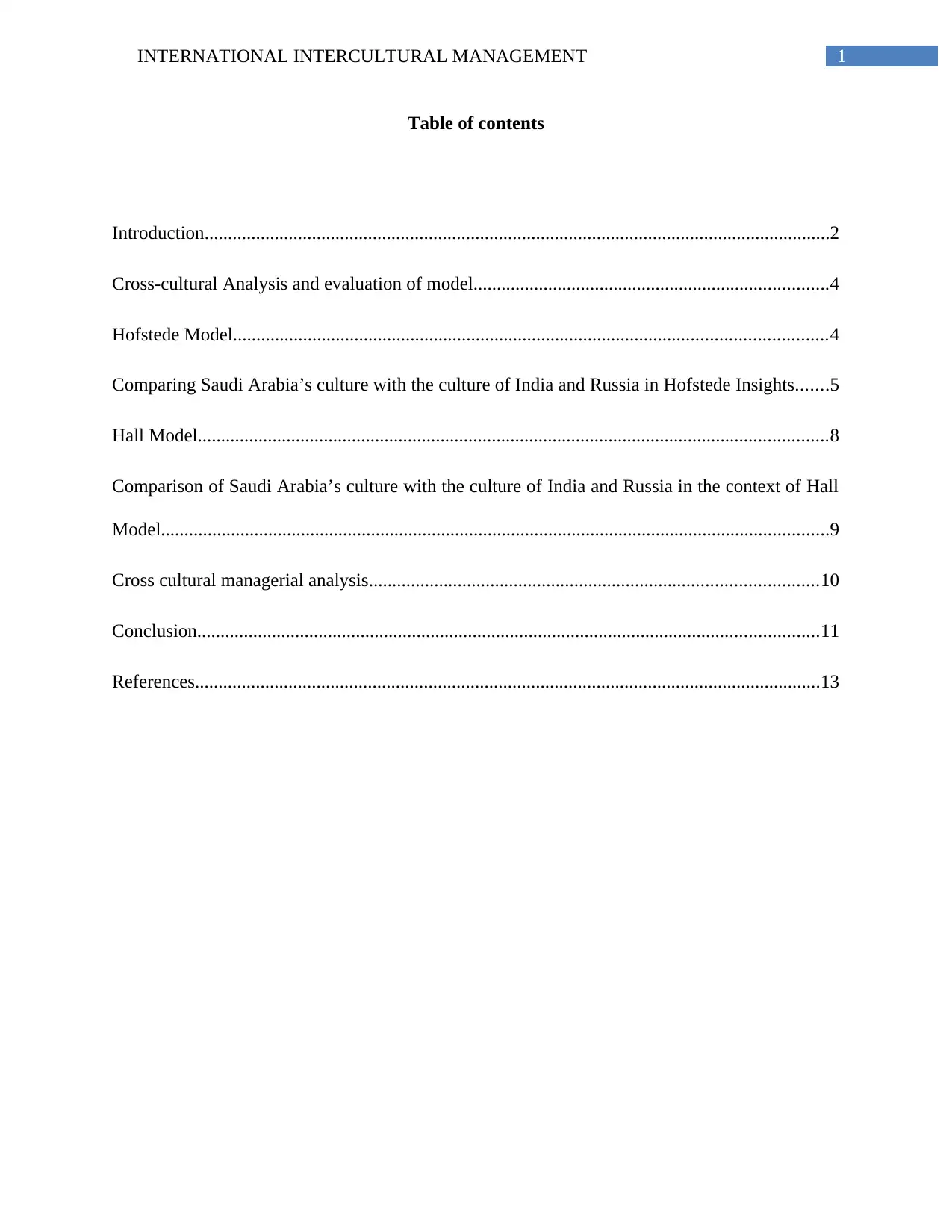
1INTERNATIONAL INTERCULTURAL MANAGEMENT
Table of contents
Introduction......................................................................................................................................2
Cross-cultural Analysis and evaluation of model............................................................................4
Hofstede Model...............................................................................................................................4
Comparing Saudi Arabia’s culture with the culture of India and Russia in Hofstede Insights.......5
Hall Model.......................................................................................................................................8
Comparison of Saudi Arabia’s culture with the culture of India and Russia in the context of Hall
Model...............................................................................................................................................9
Cross cultural managerial analysis................................................................................................10
Conclusion.....................................................................................................................................11
References......................................................................................................................................13
Table of contents
Introduction......................................................................................................................................2
Cross-cultural Analysis and evaluation of model............................................................................4
Hofstede Model...............................................................................................................................4
Comparing Saudi Arabia’s culture with the culture of India and Russia in Hofstede Insights.......5
Hall Model.......................................................................................................................................8
Comparison of Saudi Arabia’s culture with the culture of India and Russia in the context of Hall
Model...............................................................................................................................................9
Cross cultural managerial analysis................................................................................................10
Conclusion.....................................................................................................................................11
References......................................................................................................................................13
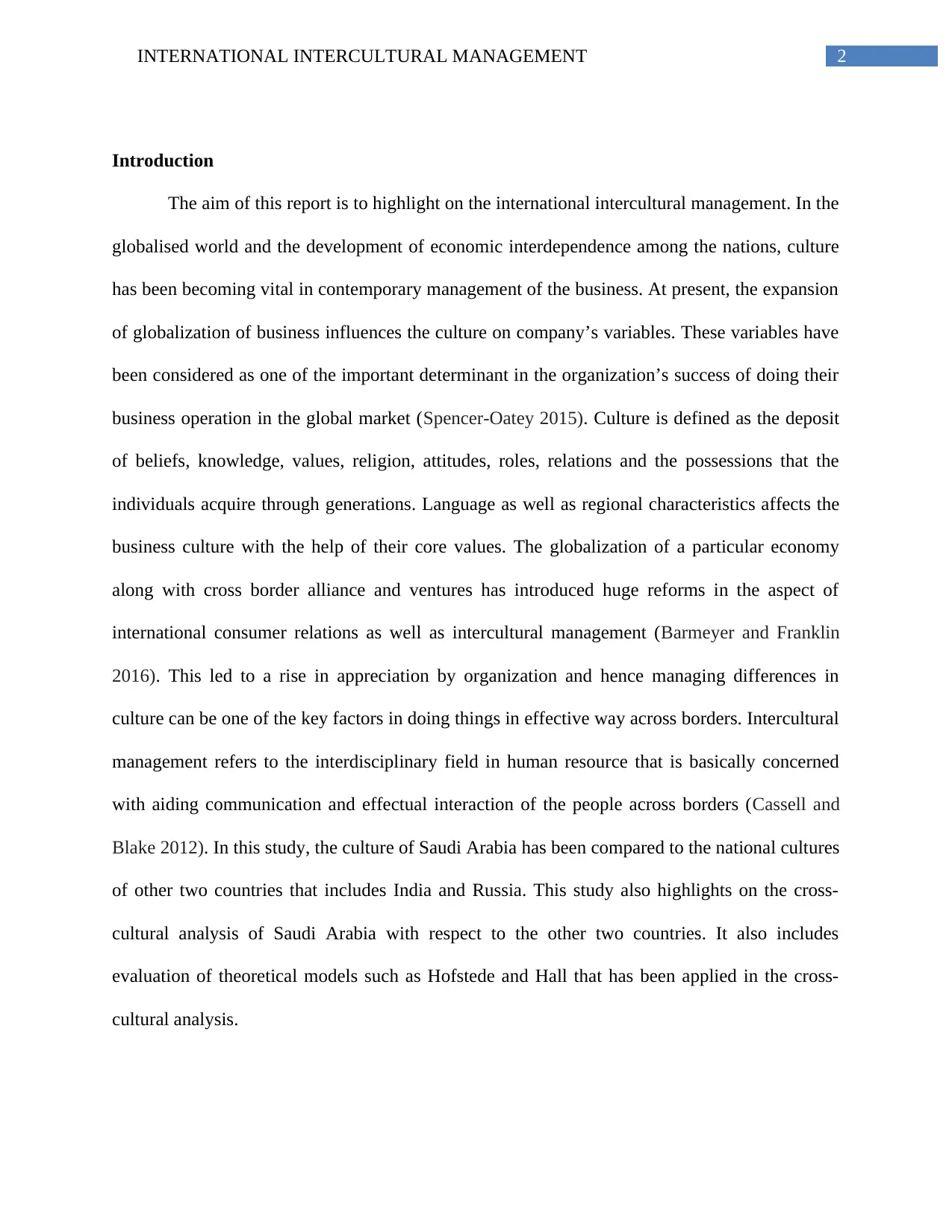
2INTERNATIONAL INTERCULTURAL MANAGEMENT
Introduction
The aim of this report is to highlight on the international intercultural management. In the
globalised world and the development of economic interdependence among the nations, culture
has been becoming vital in contemporary management of the business. At present, the expansion
of globalization of business influences the culture on company’s variables. These variables have
been considered as one of the important determinant in the organization’s success of doing their
business operation in the global market (Spencer-Oatey 2015). Culture is defined as the deposit
of beliefs, knowledge, values, religion, attitudes, roles, relations and the possessions that the
individuals acquire through generations. Language as well as regional characteristics affects the
business culture with the help of their core values. The globalization of a particular economy
along with cross border alliance and ventures has introduced huge reforms in the aspect of
international consumer relations as well as intercultural management (Barmeyer and Franklin
2016). This led to a rise in appreciation by organization and hence managing differences in
culture can be one of the key factors in doing things in effective way across borders. Intercultural
management refers to the interdisciplinary field in human resource that is basically concerned
with aiding communication and effectual interaction of the people across borders (Cassell and
Blake 2012). In this study, the culture of Saudi Arabia has been compared to the national cultures
of other two countries that includes India and Russia. This study also highlights on the cross-
cultural analysis of Saudi Arabia with respect to the other two countries. It also includes
evaluation of theoretical models such as Hofstede and Hall that has been applied in the cross-
cultural analysis.
Introduction
The aim of this report is to highlight on the international intercultural management. In the
globalised world and the development of economic interdependence among the nations, culture
has been becoming vital in contemporary management of the business. At present, the expansion
of globalization of business influences the culture on company’s variables. These variables have
been considered as one of the important determinant in the organization’s success of doing their
business operation in the global market (Spencer-Oatey 2015). Culture is defined as the deposit
of beliefs, knowledge, values, religion, attitudes, roles, relations and the possessions that the
individuals acquire through generations. Language as well as regional characteristics affects the
business culture with the help of their core values. The globalization of a particular economy
along with cross border alliance and ventures has introduced huge reforms in the aspect of
international consumer relations as well as intercultural management (Barmeyer and Franklin
2016). This led to a rise in appreciation by organization and hence managing differences in
culture can be one of the key factors in doing things in effective way across borders. Intercultural
management refers to the interdisciplinary field in human resource that is basically concerned
with aiding communication and effectual interaction of the people across borders (Cassell and
Blake 2012). In this study, the culture of Saudi Arabia has been compared to the national cultures
of other two countries that includes India and Russia. This study also highlights on the cross-
cultural analysis of Saudi Arabia with respect to the other two countries. It also includes
evaluation of theoretical models such as Hofstede and Hall that has been applied in the cross-
cultural analysis.
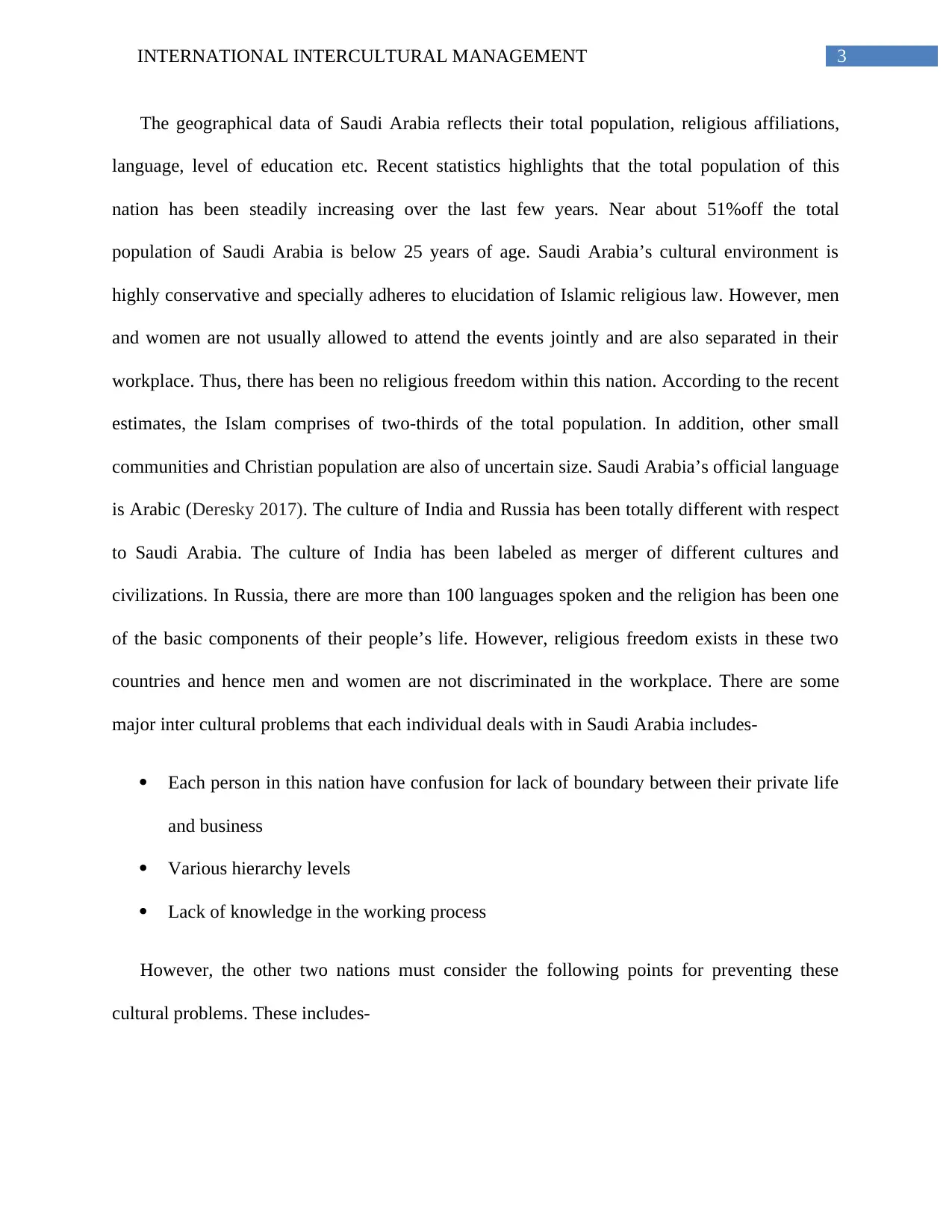
3INTERNATIONAL INTERCULTURAL MANAGEMENT
The geographical data of Saudi Arabia reflects their total population, religious affiliations,
language, level of education etc. Recent statistics highlights that the total population of this
nation has been steadily increasing over the last few years. Near about 51%off the total
population of Saudi Arabia is below 25 years of age. Saudi Arabia’s cultural environment is
highly conservative and specially adheres to elucidation of Islamic religious law. However, men
and women are not usually allowed to attend the events jointly and are also separated in their
workplace. Thus, there has been no religious freedom within this nation. According to the recent
estimates, the Islam comprises of two-thirds of the total population. In addition, other small
communities and Christian population are also of uncertain size. Saudi Arabia’s official language
is Arabic (Deresky 2017). The culture of India and Russia has been totally different with respect
to Saudi Arabia. The culture of India has been labeled as merger of different cultures and
civilizations. In Russia, there are more than 100 languages spoken and the religion has been one
of the basic components of their people’s life. However, religious freedom exists in these two
countries and hence men and women are not discriminated in the workplace. There are some
major inter cultural problems that each individual deals with in Saudi Arabia includes-
Each person in this nation have confusion for lack of boundary between their private life
and business
Various hierarchy levels
Lack of knowledge in the working process
However, the other two nations must consider the following points for preventing these
cultural problems. These includes-
The geographical data of Saudi Arabia reflects their total population, religious affiliations,
language, level of education etc. Recent statistics highlights that the total population of this
nation has been steadily increasing over the last few years. Near about 51%off the total
population of Saudi Arabia is below 25 years of age. Saudi Arabia’s cultural environment is
highly conservative and specially adheres to elucidation of Islamic religious law. However, men
and women are not usually allowed to attend the events jointly and are also separated in their
workplace. Thus, there has been no religious freedom within this nation. According to the recent
estimates, the Islam comprises of two-thirds of the total population. In addition, other small
communities and Christian population are also of uncertain size. Saudi Arabia’s official language
is Arabic (Deresky 2017). The culture of India and Russia has been totally different with respect
to Saudi Arabia. The culture of India has been labeled as merger of different cultures and
civilizations. In Russia, there are more than 100 languages spoken and the religion has been one
of the basic components of their people’s life. However, religious freedom exists in these two
countries and hence men and women are not discriminated in the workplace. There are some
major inter cultural problems that each individual deals with in Saudi Arabia includes-
Each person in this nation have confusion for lack of boundary between their private life
and business
Various hierarchy levels
Lack of knowledge in the working process
However, the other two nations must consider the following points for preventing these
cultural problems. These includes-
Secure Best Marks with AI Grader
Need help grading? Try our AI Grader for instant feedback on your assignments.
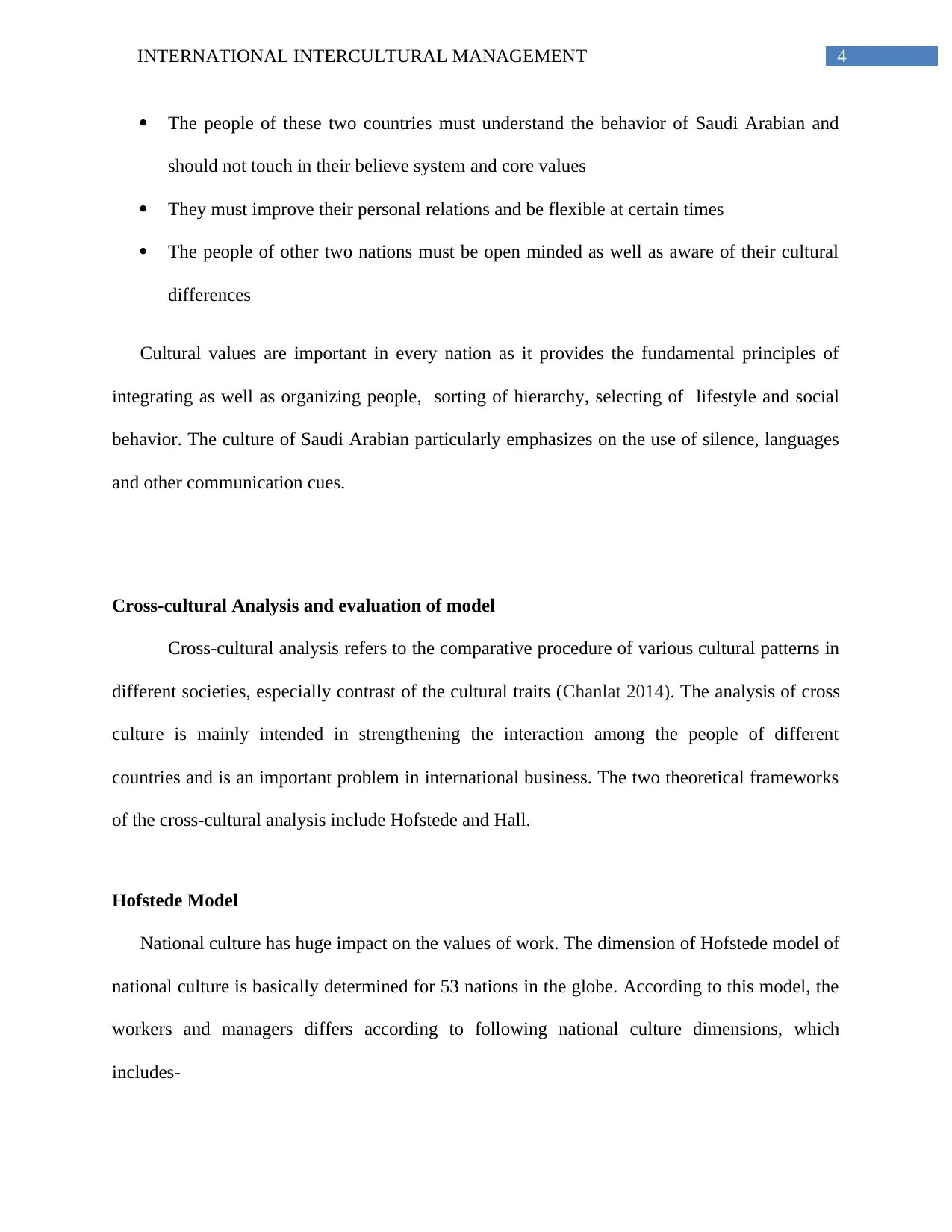
4INTERNATIONAL INTERCULTURAL MANAGEMENT
The people of these two countries must understand the behavior of Saudi Arabian and
should not touch in their believe system and core values
They must improve their personal relations and be flexible at certain times
The people of other two nations must be open minded as well as aware of their cultural
differences
Cultural values are important in every nation as it provides the fundamental principles of
integrating as well as organizing people, sorting of hierarchy, selecting of lifestyle and social
behavior. The culture of Saudi Arabian particularly emphasizes on the use of silence, languages
and other communication cues.
Cross-cultural Analysis and evaluation of model
Cross-cultural analysis refers to the comparative procedure of various cultural patterns in
different societies, especially contrast of the cultural traits (Chanlat 2014). The analysis of cross
culture is mainly intended in strengthening the interaction among the people of different
countries and is an important problem in international business. The two theoretical frameworks
of the cross-cultural analysis include Hofstede and Hall.
Hofstede Model
National culture has huge impact on the values of work. The dimension of Hofstede model of
national culture is basically determined for 53 nations in the globe. According to this model, the
workers and managers differs according to following national culture dimensions, which
includes-
The people of these two countries must understand the behavior of Saudi Arabian and
should not touch in their believe system and core values
They must improve their personal relations and be flexible at certain times
The people of other two nations must be open minded as well as aware of their cultural
differences
Cultural values are important in every nation as it provides the fundamental principles of
integrating as well as organizing people, sorting of hierarchy, selecting of lifestyle and social
behavior. The culture of Saudi Arabian particularly emphasizes on the use of silence, languages
and other communication cues.
Cross-cultural Analysis and evaluation of model
Cross-cultural analysis refers to the comparative procedure of various cultural patterns in
different societies, especially contrast of the cultural traits (Chanlat 2014). The analysis of cross
culture is mainly intended in strengthening the interaction among the people of different
countries and is an important problem in international business. The two theoretical frameworks
of the cross-cultural analysis include Hofstede and Hall.
Hofstede Model
National culture has huge impact on the values of work. The dimension of Hofstede model of
national culture is basically determined for 53 nations in the globe. According to this model, the
workers and managers differs according to following national culture dimensions, which
includes-
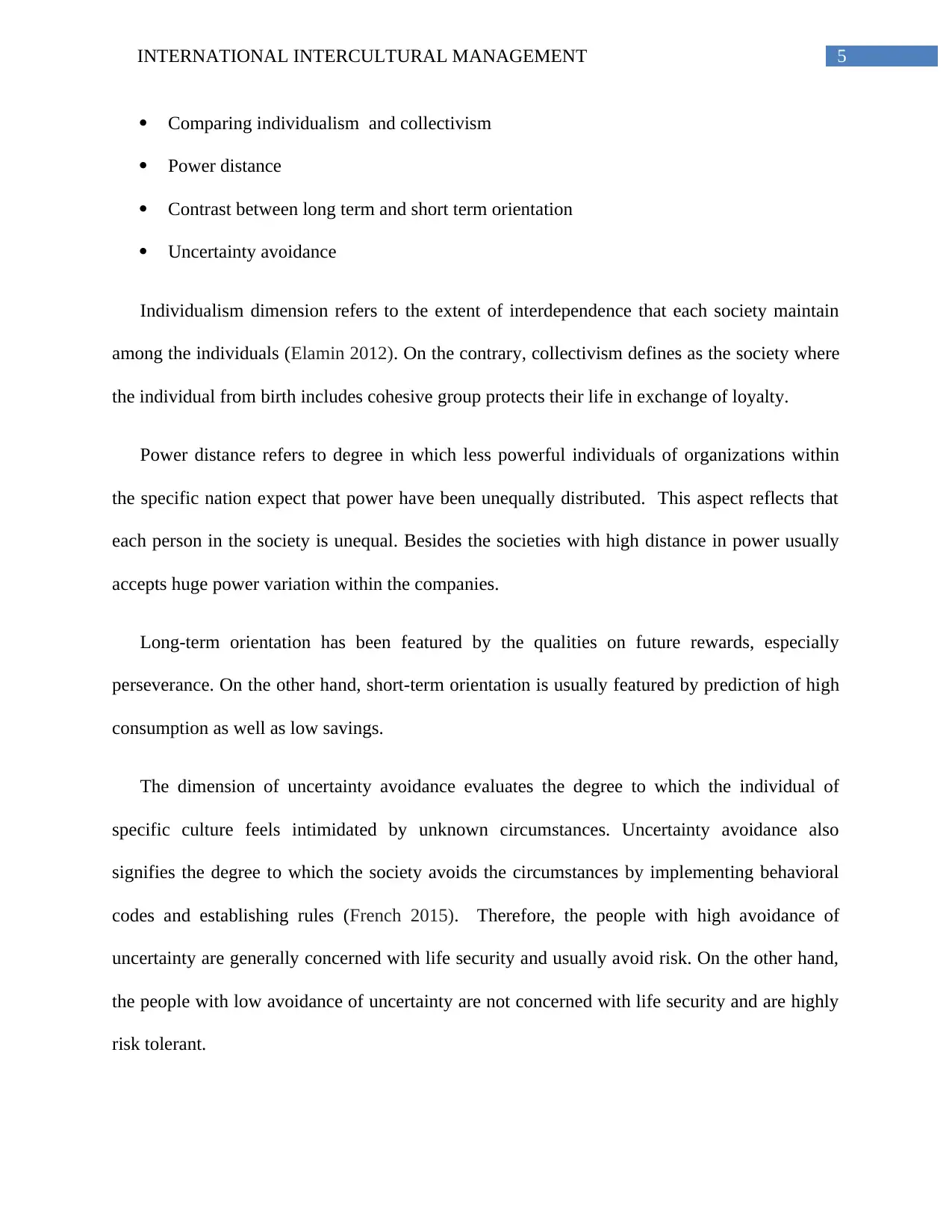
5INTERNATIONAL INTERCULTURAL MANAGEMENT
Comparing individualism and collectivism
Power distance
Contrast between long term and short term orientation
Uncertainty avoidance
Individualism dimension refers to the extent of interdependence that each society maintain
among the individuals (Elamin 2012). On the contrary, collectivism defines as the society where
the individual from birth includes cohesive group protects their life in exchange of loyalty.
Power distance refers to degree in which less powerful individuals of organizations within
the specific nation expect that power have been unequally distributed. This aspect reflects that
each person in the society is unequal. Besides the societies with high distance in power usually
accepts huge power variation within the companies.
Long-term orientation has been featured by the qualities on future rewards, especially
perseverance. On the other hand, short-term orientation is usually featured by prediction of high
consumption as well as low savings.
The dimension of uncertainty avoidance evaluates the degree to which the individual of
specific culture feels intimidated by unknown circumstances. Uncertainty avoidance also
signifies the degree to which the society avoids the circumstances by implementing behavioral
codes and establishing rules (French 2015). Therefore, the people with high avoidance of
uncertainty are generally concerned with life security and usually avoid risk. On the other hand,
the people with low avoidance of uncertainty are not concerned with life security and are highly
risk tolerant.
Comparing individualism and collectivism
Power distance
Contrast between long term and short term orientation
Uncertainty avoidance
Individualism dimension refers to the extent of interdependence that each society maintain
among the individuals (Elamin 2012). On the contrary, collectivism defines as the society where
the individual from birth includes cohesive group protects their life in exchange of loyalty.
Power distance refers to degree in which less powerful individuals of organizations within
the specific nation expect that power have been unequally distributed. This aspect reflects that
each person in the society is unequal. Besides the societies with high distance in power usually
accepts huge power variation within the companies.
Long-term orientation has been featured by the qualities on future rewards, especially
perseverance. On the other hand, short-term orientation is usually featured by prediction of high
consumption as well as low savings.
The dimension of uncertainty avoidance evaluates the degree to which the individual of
specific culture feels intimidated by unknown circumstances. Uncertainty avoidance also
signifies the degree to which the society avoids the circumstances by implementing behavioral
codes and establishing rules (French 2015). Therefore, the people with high avoidance of
uncertainty are generally concerned with life security and usually avoid risk. On the other hand,
the people with low avoidance of uncertainty are not concerned with life security and are highly
risk tolerant.
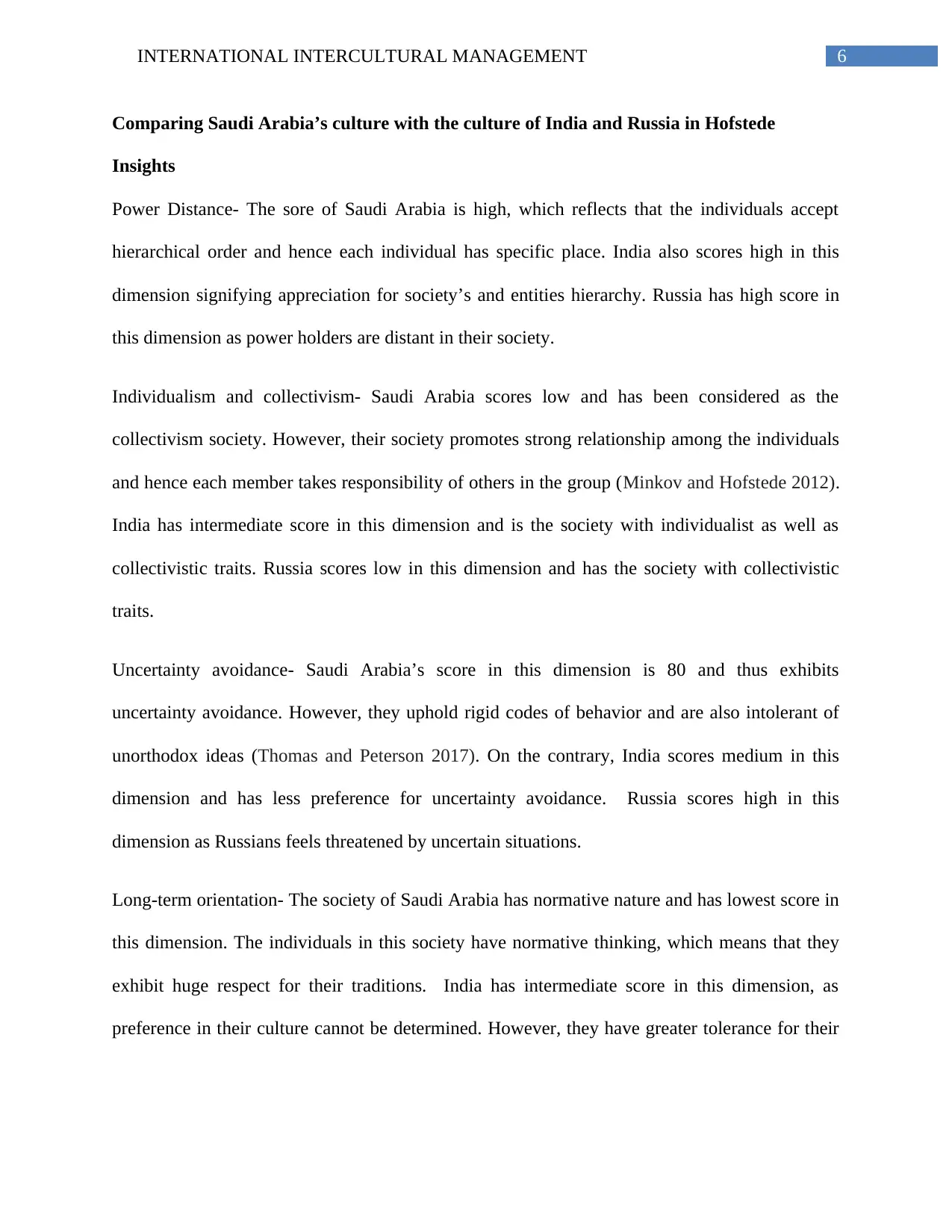
6INTERNATIONAL INTERCULTURAL MANAGEMENT
Comparing Saudi Arabia’s culture with the culture of India and Russia in Hofstede
Insights
Power Distance- The sore of Saudi Arabia is high, which reflects that the individuals accept
hierarchical order and hence each individual has specific place. India also scores high in this
dimension signifying appreciation for society’s and entities hierarchy. Russia has high score in
this dimension as power holders are distant in their society.
Individualism and collectivism- Saudi Arabia scores low and has been considered as the
collectivism society. However, their society promotes strong relationship among the individuals
and hence each member takes responsibility of others in the group (Minkov and Hofstede 2012).
India has intermediate score in this dimension and is the society with individualist as well as
collectivistic traits. Russia scores low in this dimension and has the society with collectivistic
traits.
Uncertainty avoidance- Saudi Arabia’s score in this dimension is 80 and thus exhibits
uncertainty avoidance. However, they uphold rigid codes of behavior and are also intolerant of
unorthodox ideas (Thomas and Peterson 2017). On the contrary, India scores medium in this
dimension and has less preference for uncertainty avoidance. Russia scores high in this
dimension as Russians feels threatened by uncertain situations.
Long-term orientation- The society of Saudi Arabia has normative nature and has lowest score in
this dimension. The individuals in this society have normative thinking, which means that they
exhibit huge respect for their traditions. India has intermediate score in this dimension, as
preference in their culture cannot be determined. However, they have greater tolerance for their
Comparing Saudi Arabia’s culture with the culture of India and Russia in Hofstede
Insights
Power Distance- The sore of Saudi Arabia is high, which reflects that the individuals accept
hierarchical order and hence each individual has specific place. India also scores high in this
dimension signifying appreciation for society’s and entities hierarchy. Russia has high score in
this dimension as power holders are distant in their society.
Individualism and collectivism- Saudi Arabia scores low and has been considered as the
collectivism society. However, their society promotes strong relationship among the individuals
and hence each member takes responsibility of others in the group (Minkov and Hofstede 2012).
India has intermediate score in this dimension and is the society with individualist as well as
collectivistic traits. Russia scores low in this dimension and has the society with collectivistic
traits.
Uncertainty avoidance- Saudi Arabia’s score in this dimension is 80 and thus exhibits
uncertainty avoidance. However, they uphold rigid codes of behavior and are also intolerant of
unorthodox ideas (Thomas and Peterson 2017). On the contrary, India scores medium in this
dimension and has less preference for uncertainty avoidance. Russia scores high in this
dimension as Russians feels threatened by uncertain situations.
Long-term orientation- The society of Saudi Arabia has normative nature and has lowest score in
this dimension. The individuals in this society have normative thinking, which means that they
exhibit huge respect for their traditions. India has intermediate score in this dimension, as
preference in their culture cannot be determined. However, they have greater tolerance for their
Paraphrase This Document
Need a fresh take? Get an instant paraphrase of this document with our AI Paraphraser
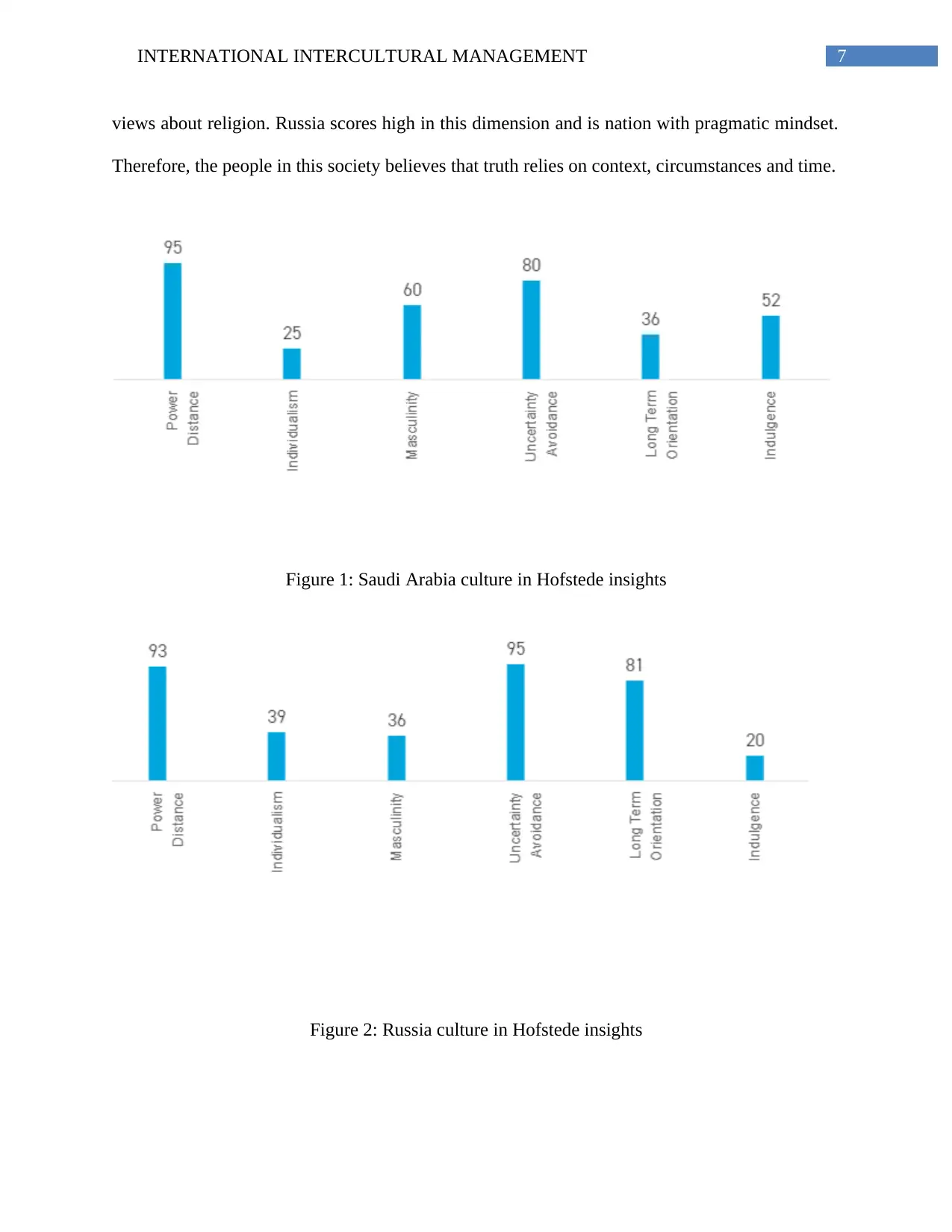
7INTERNATIONAL INTERCULTURAL MANAGEMENT
views about religion. Russia scores high in this dimension and is nation with pragmatic mindset.
Therefore, the people in this society believes that truth relies on context, circumstances and time.
Figure 1: Saudi Arabia culture in Hofstede insights
Figure 2: Russia culture in Hofstede insights
views about religion. Russia scores high in this dimension and is nation with pragmatic mindset.
Therefore, the people in this society believes that truth relies on context, circumstances and time.
Figure 1: Saudi Arabia culture in Hofstede insights
Figure 2: Russia culture in Hofstede insights
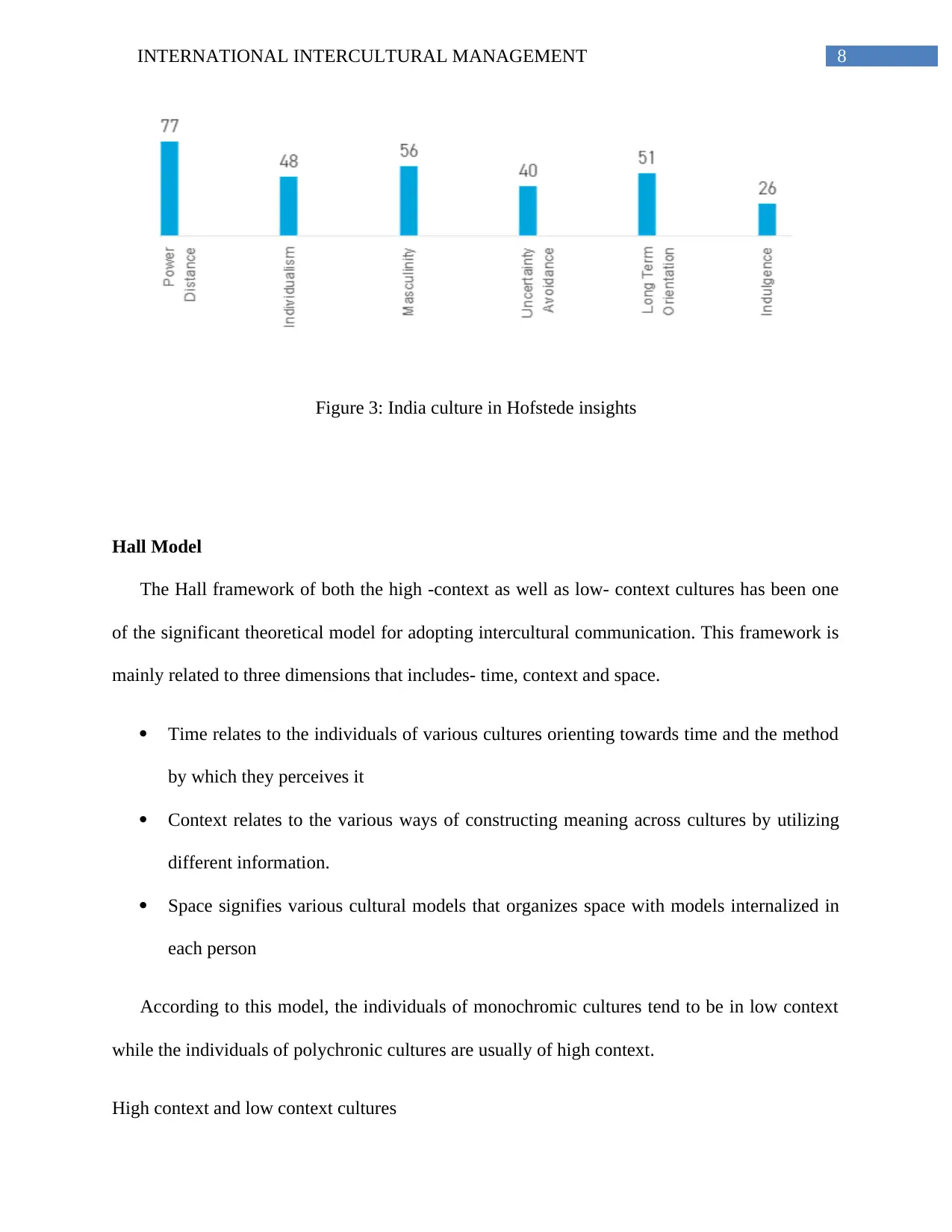
8INTERNATIONAL INTERCULTURAL MANAGEMENT
Figure 3: India culture in Hofstede insights
Hall Model
The Hall framework of both the high -context as well as low- context cultures has been one
of the significant theoretical model for adopting intercultural communication. This framework is
mainly related to three dimensions that includes- time, context and space.
Time relates to the individuals of various cultures orienting towards time and the method
by which they perceives it
Context relates to the various ways of constructing meaning across cultures by utilizing
different information.
Space signifies various cultural models that organizes space with models internalized in
each person
According to this model, the individuals of monochromic cultures tend to be in low context
while the individuals of polychronic cultures are usually of high context.
High context and low context cultures
Figure 3: India culture in Hofstede insights
Hall Model
The Hall framework of both the high -context as well as low- context cultures has been one
of the significant theoretical model for adopting intercultural communication. This framework is
mainly related to three dimensions that includes- time, context and space.
Time relates to the individuals of various cultures orienting towards time and the method
by which they perceives it
Context relates to the various ways of constructing meaning across cultures by utilizing
different information.
Space signifies various cultural models that organizes space with models internalized in
each person
According to this model, the individuals of monochromic cultures tend to be in low context
while the individuals of polychronic cultures are usually of high context.
High context and low context cultures
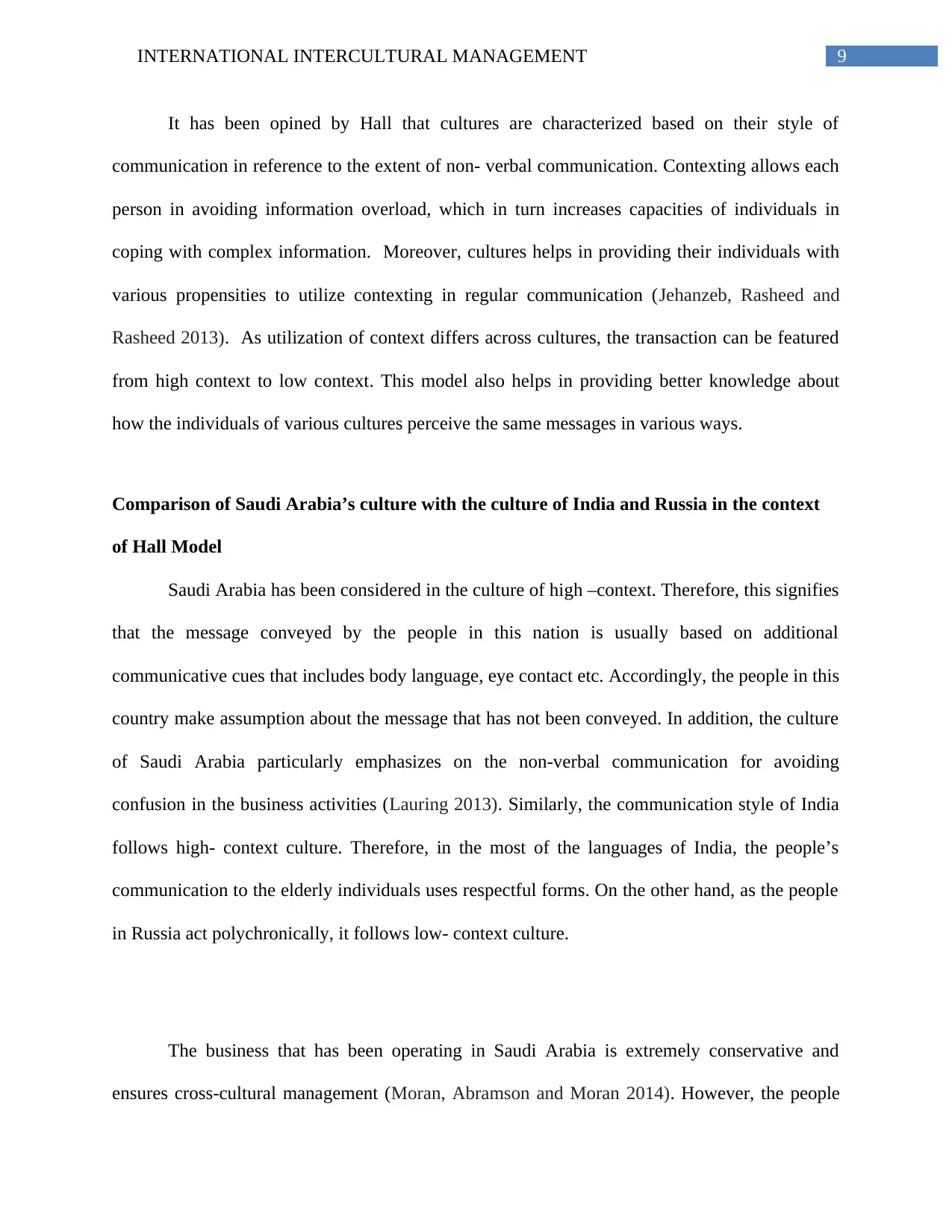
9INTERNATIONAL INTERCULTURAL MANAGEMENT
It has been opined by Hall that cultures are characterized based on their style of
communication in reference to the extent of non- verbal communication. Contexting allows each
person in avoiding information overload, which in turn increases capacities of individuals in
coping with complex information. Moreover, cultures helps in providing their individuals with
various propensities to utilize contexting in regular communication (Jehanzeb, Rasheed and
Rasheed 2013). As utilization of context differs across cultures, the transaction can be featured
from high context to low context. This model also helps in providing better knowledge about
how the individuals of various cultures perceive the same messages in various ways.
Comparison of Saudi Arabia’s culture with the culture of India and Russia in the context
of Hall Model
Saudi Arabia has been considered in the culture of high –context. Therefore, this signifies
that the message conveyed by the people in this nation is usually based on additional
communicative cues that includes body language, eye contact etc. Accordingly, the people in this
country make assumption about the message that has not been conveyed. In addition, the culture
of Saudi Arabia particularly emphasizes on the non-verbal communication for avoiding
confusion in the business activities (Lauring 2013). Similarly, the communication style of India
follows high- context culture. Therefore, in the most of the languages of India, the people’s
communication to the elderly individuals uses respectful forms. On the other hand, as the people
in Russia act polychronically, it follows low- context culture.
The business that has been operating in Saudi Arabia is extremely conservative and
ensures cross-cultural management (Moran, Abramson and Moran 2014). However, the people
It has been opined by Hall that cultures are characterized based on their style of
communication in reference to the extent of non- verbal communication. Contexting allows each
person in avoiding information overload, which in turn increases capacities of individuals in
coping with complex information. Moreover, cultures helps in providing their individuals with
various propensities to utilize contexting in regular communication (Jehanzeb, Rasheed and
Rasheed 2013). As utilization of context differs across cultures, the transaction can be featured
from high context to low context. This model also helps in providing better knowledge about
how the individuals of various cultures perceive the same messages in various ways.
Comparison of Saudi Arabia’s culture with the culture of India and Russia in the context
of Hall Model
Saudi Arabia has been considered in the culture of high –context. Therefore, this signifies
that the message conveyed by the people in this nation is usually based on additional
communicative cues that includes body language, eye contact etc. Accordingly, the people in this
country make assumption about the message that has not been conveyed. In addition, the culture
of Saudi Arabia particularly emphasizes on the non-verbal communication for avoiding
confusion in the business activities (Lauring 2013). Similarly, the communication style of India
follows high- context culture. Therefore, in the most of the languages of India, the people’s
communication to the elderly individuals uses respectful forms. On the other hand, as the people
in Russia act polychronically, it follows low- context culture.
The business that has been operating in Saudi Arabia is extremely conservative and
ensures cross-cultural management (Moran, Abramson and Moran 2014). However, the people
Secure Best Marks with AI Grader
Need help grading? Try our AI Grader for instant feedback on your assignments.
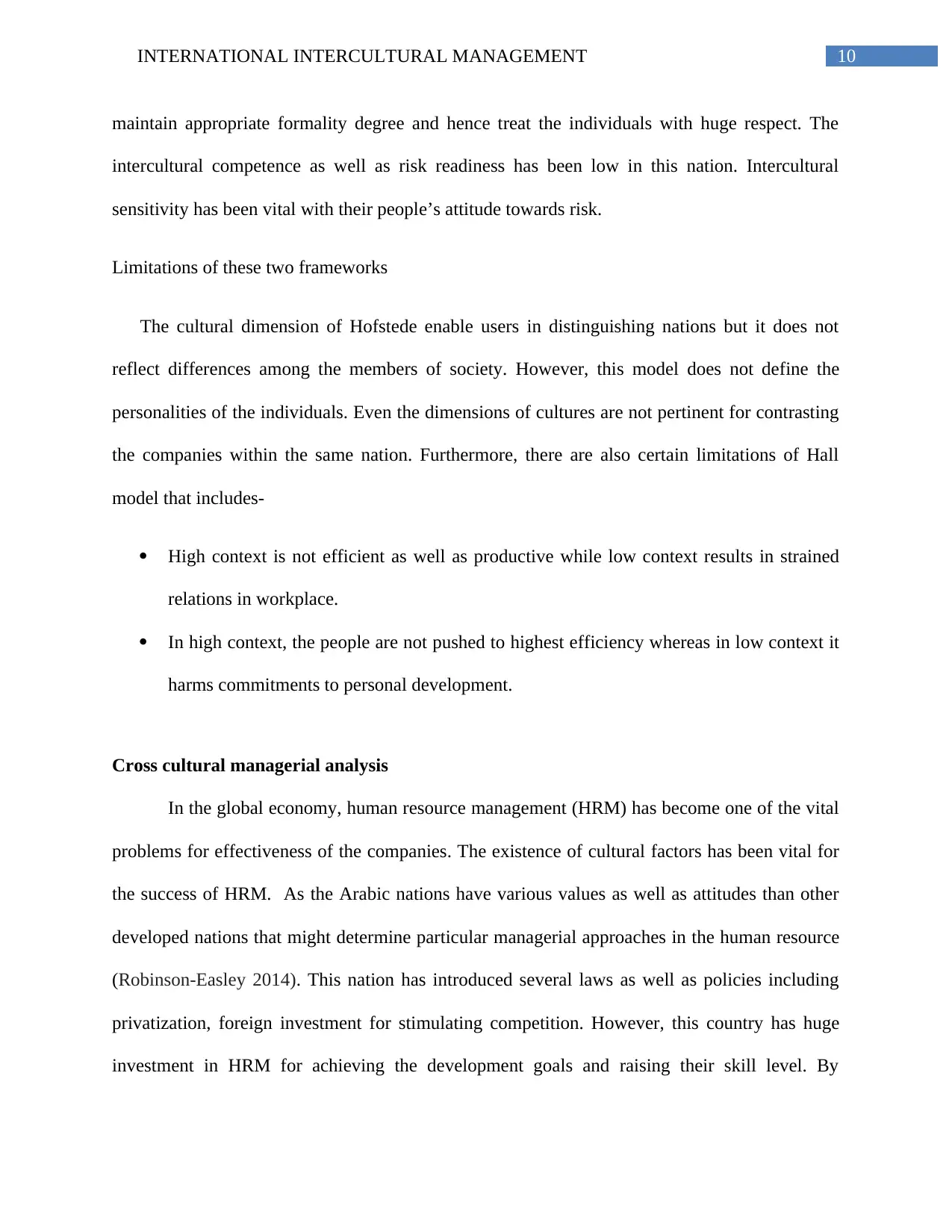
10INTERNATIONAL INTERCULTURAL MANAGEMENT
maintain appropriate formality degree and hence treat the individuals with huge respect. The
intercultural competence as well as risk readiness has been low in this nation. Intercultural
sensitivity has been vital with their people’s attitude towards risk.
Limitations of these two frameworks
The cultural dimension of Hofstede enable users in distinguishing nations but it does not
reflect differences among the members of society. However, this model does not define the
personalities of the individuals. Even the dimensions of cultures are not pertinent for contrasting
the companies within the same nation. Furthermore, there are also certain limitations of Hall
model that includes-
High context is not efficient as well as productive while low context results in strained
relations in workplace.
In high context, the people are not pushed to highest efficiency whereas in low context it
harms commitments to personal development.
Cross cultural managerial analysis
In the global economy, human resource management (HRM) has become one of the vital
problems for effectiveness of the companies. The existence of cultural factors has been vital for
the success of HRM. As the Arabic nations have various values as well as attitudes than other
developed nations that might determine particular managerial approaches in the human resource
(Robinson-Easley 2014). This nation has introduced several laws as well as policies including
privatization, foreign investment for stimulating competition. However, this country has huge
investment in HRM for achieving the development goals and raising their skill level. By
maintain appropriate formality degree and hence treat the individuals with huge respect. The
intercultural competence as well as risk readiness has been low in this nation. Intercultural
sensitivity has been vital with their people’s attitude towards risk.
Limitations of these two frameworks
The cultural dimension of Hofstede enable users in distinguishing nations but it does not
reflect differences among the members of society. However, this model does not define the
personalities of the individuals. Even the dimensions of cultures are not pertinent for contrasting
the companies within the same nation. Furthermore, there are also certain limitations of Hall
model that includes-
High context is not efficient as well as productive while low context results in strained
relations in workplace.
In high context, the people are not pushed to highest efficiency whereas in low context it
harms commitments to personal development.
Cross cultural managerial analysis
In the global economy, human resource management (HRM) has become one of the vital
problems for effectiveness of the companies. The existence of cultural factors has been vital for
the success of HRM. As the Arabic nations have various values as well as attitudes than other
developed nations that might determine particular managerial approaches in the human resource
(Robinson-Easley 2014). This nation has introduced several laws as well as policies including
privatization, foreign investment for stimulating competition. However, this country has huge
investment in HRM for achieving the development goals and raising their skill level. By
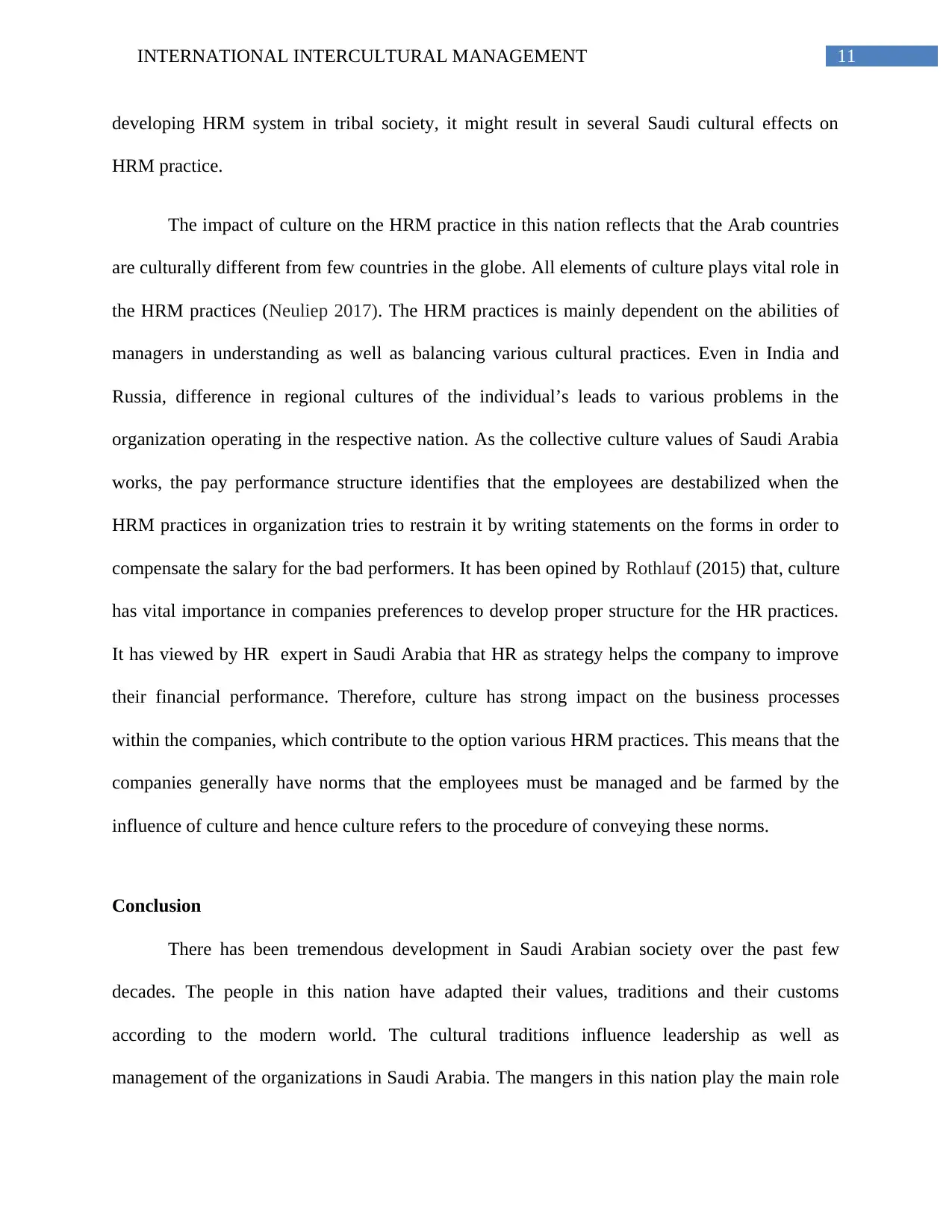
11INTERNATIONAL INTERCULTURAL MANAGEMENT
developing HRM system in tribal society, it might result in several Saudi cultural effects on
HRM practice.
The impact of culture on the HRM practice in this nation reflects that the Arab countries
are culturally different from few countries in the globe. All elements of culture plays vital role in
the HRM practices (Neuliep 2017). The HRM practices is mainly dependent on the abilities of
managers in understanding as well as balancing various cultural practices. Even in India and
Russia, difference in regional cultures of the individual’s leads to various problems in the
organization operating in the respective nation. As the collective culture values of Saudi Arabia
works, the pay performance structure identifies that the employees are destabilized when the
HRM practices in organization tries to restrain it by writing statements on the forms in order to
compensate the salary for the bad performers. It has been opined by Rothlauf (2015) that, culture
has vital importance in companies preferences to develop proper structure for the HR practices.
It has viewed by HR expert in Saudi Arabia that HR as strategy helps the company to improve
their financial performance. Therefore, culture has strong impact on the business processes
within the companies, which contribute to the option various HRM practices. This means that the
companies generally have norms that the employees must be managed and be farmed by the
influence of culture and hence culture refers to the procedure of conveying these norms.
Conclusion
There has been tremendous development in Saudi Arabian society over the past few
decades. The people in this nation have adapted their values, traditions and their customs
according to the modern world. The cultural traditions influence leadership as well as
management of the organizations in Saudi Arabia. The mangers in this nation play the main role
developing HRM system in tribal society, it might result in several Saudi cultural effects on
HRM practice.
The impact of culture on the HRM practice in this nation reflects that the Arab countries
are culturally different from few countries in the globe. All elements of culture plays vital role in
the HRM practices (Neuliep 2017). The HRM practices is mainly dependent on the abilities of
managers in understanding as well as balancing various cultural practices. Even in India and
Russia, difference in regional cultures of the individual’s leads to various problems in the
organization operating in the respective nation. As the collective culture values of Saudi Arabia
works, the pay performance structure identifies that the employees are destabilized when the
HRM practices in organization tries to restrain it by writing statements on the forms in order to
compensate the salary for the bad performers. It has been opined by Rothlauf (2015) that, culture
has vital importance in companies preferences to develop proper structure for the HR practices.
It has viewed by HR expert in Saudi Arabia that HR as strategy helps the company to improve
their financial performance. Therefore, culture has strong impact on the business processes
within the companies, which contribute to the option various HRM practices. This means that the
companies generally have norms that the employees must be managed and be farmed by the
influence of culture and hence culture refers to the procedure of conveying these norms.
Conclusion
There has been tremendous development in Saudi Arabian society over the past few
decades. The people in this nation have adapted their values, traditions and their customs
according to the modern world. The cultural traditions influence leadership as well as
management of the organizations in Saudi Arabia. The mangers in this nation play the main role
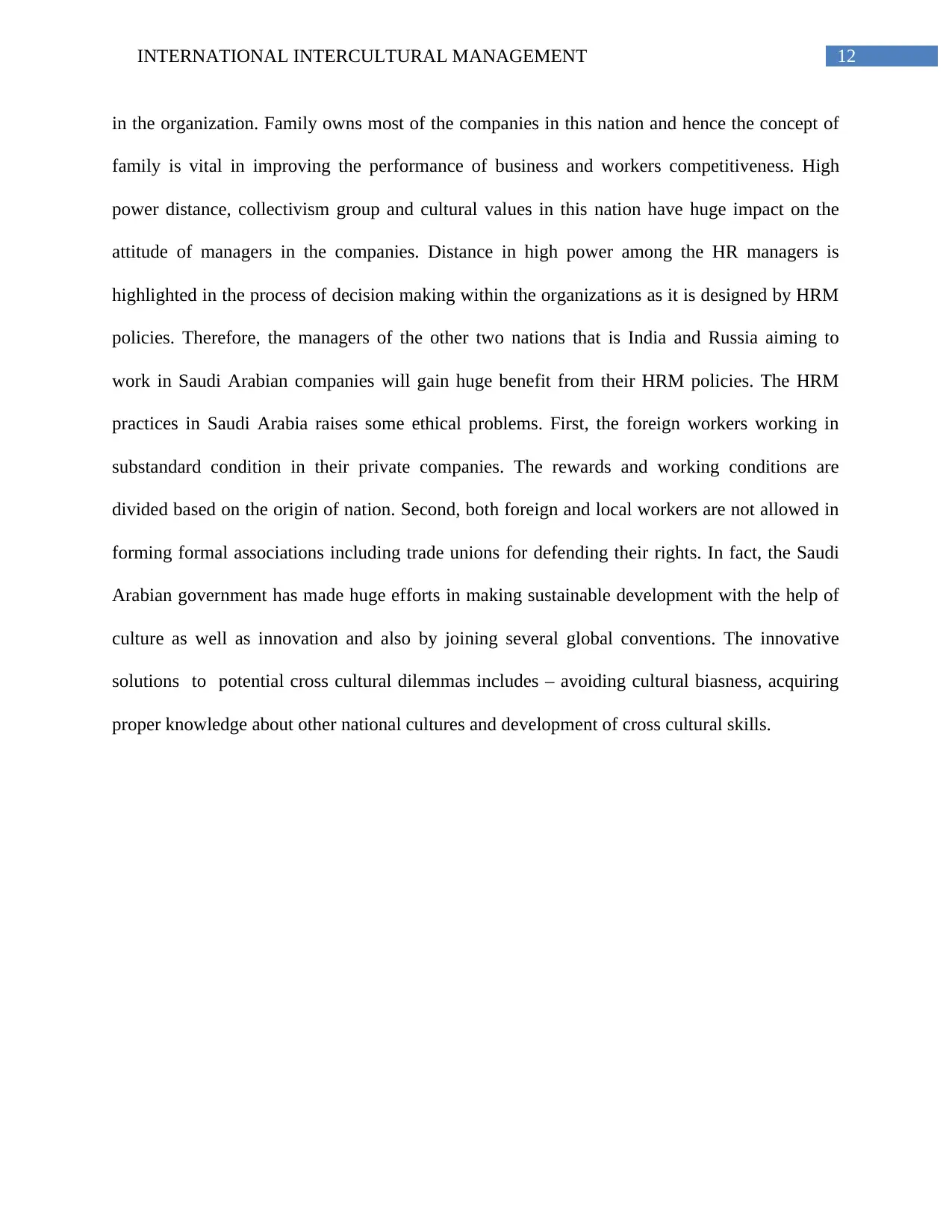
12INTERNATIONAL INTERCULTURAL MANAGEMENT
in the organization. Family owns most of the companies in this nation and hence the concept of
family is vital in improving the performance of business and workers competitiveness. High
power distance, collectivism group and cultural values in this nation have huge impact on the
attitude of managers in the companies. Distance in high power among the HR managers is
highlighted in the process of decision making within the organizations as it is designed by HRM
policies. Therefore, the managers of the other two nations that is India and Russia aiming to
work in Saudi Arabian companies will gain huge benefit from their HRM policies. The HRM
practices in Saudi Arabia raises some ethical problems. First, the foreign workers working in
substandard condition in their private companies. The rewards and working conditions are
divided based on the origin of nation. Second, both foreign and local workers are not allowed in
forming formal associations including trade unions for defending their rights. In fact, the Saudi
Arabian government has made huge efforts in making sustainable development with the help of
culture as well as innovation and also by joining several global conventions. The innovative
solutions to potential cross cultural dilemmas includes – avoiding cultural biasness, acquiring
proper knowledge about other national cultures and development of cross cultural skills.
in the organization. Family owns most of the companies in this nation and hence the concept of
family is vital in improving the performance of business and workers competitiveness. High
power distance, collectivism group and cultural values in this nation have huge impact on the
attitude of managers in the companies. Distance in high power among the HR managers is
highlighted in the process of decision making within the organizations as it is designed by HRM
policies. Therefore, the managers of the other two nations that is India and Russia aiming to
work in Saudi Arabian companies will gain huge benefit from their HRM policies. The HRM
practices in Saudi Arabia raises some ethical problems. First, the foreign workers working in
substandard condition in their private companies. The rewards and working conditions are
divided based on the origin of nation. Second, both foreign and local workers are not allowed in
forming formal associations including trade unions for defending their rights. In fact, the Saudi
Arabian government has made huge efforts in making sustainable development with the help of
culture as well as innovation and also by joining several global conventions. The innovative
solutions to potential cross cultural dilemmas includes – avoiding cultural biasness, acquiring
proper knowledge about other national cultures and development of cross cultural skills.
Paraphrase This Document
Need a fresh take? Get an instant paraphrase of this document with our AI Paraphraser
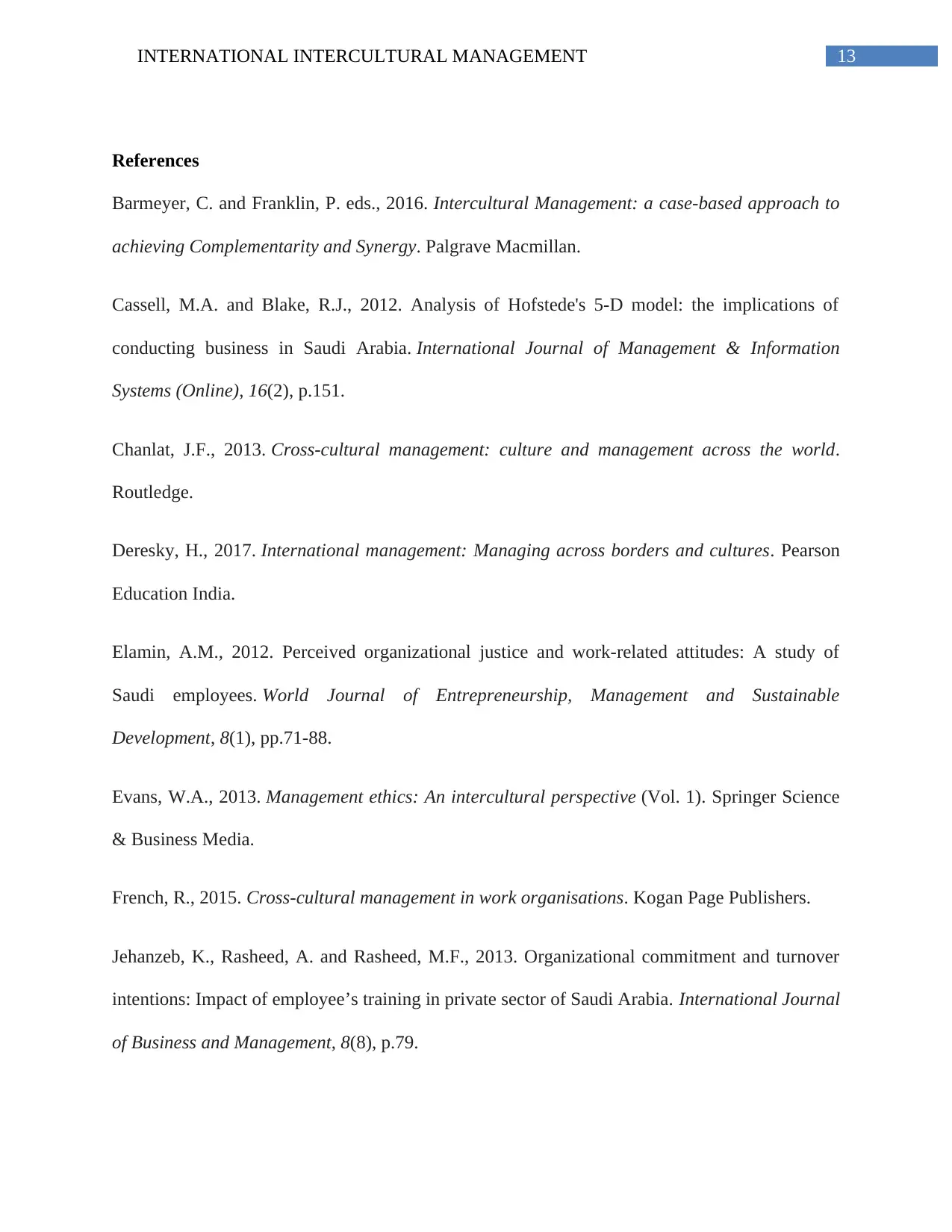
13INTERNATIONAL INTERCULTURAL MANAGEMENT
References
Barmeyer, C. and Franklin, P. eds., 2016. Intercultural Management: a case-based approach to
achieving Complementarity and Synergy. Palgrave Macmillan.
Cassell, M.A. and Blake, R.J., 2012. Analysis of Hofstede's 5-D model: the implications of
conducting business in Saudi Arabia. International Journal of Management & Information
Systems (Online), 16(2), p.151.
Chanlat, J.F., 2013. Cross-cultural management: culture and management across the world.
Routledge.
Deresky, H., 2017. International management: Managing across borders and cultures. Pearson
Education India.
Elamin, A.M., 2012. Perceived organizational justice and work-related attitudes: A study of
Saudi employees. World Journal of Entrepreneurship, Management and Sustainable
Development, 8(1), pp.71-88.
Evans, W.A., 2013. Management ethics: An intercultural perspective (Vol. 1). Springer Science
& Business Media.
French, R., 2015. Cross-cultural management in work organisations. Kogan Page Publishers.
Jehanzeb, K., Rasheed, A. and Rasheed, M.F., 2013. Organizational commitment and turnover
intentions: Impact of employee’s training in private sector of Saudi Arabia. International Journal
of Business and Management, 8(8), p.79.
References
Barmeyer, C. and Franklin, P. eds., 2016. Intercultural Management: a case-based approach to
achieving Complementarity and Synergy. Palgrave Macmillan.
Cassell, M.A. and Blake, R.J., 2012. Analysis of Hofstede's 5-D model: the implications of
conducting business in Saudi Arabia. International Journal of Management & Information
Systems (Online), 16(2), p.151.
Chanlat, J.F., 2013. Cross-cultural management: culture and management across the world.
Routledge.
Deresky, H., 2017. International management: Managing across borders and cultures. Pearson
Education India.
Elamin, A.M., 2012. Perceived organizational justice and work-related attitudes: A study of
Saudi employees. World Journal of Entrepreneurship, Management and Sustainable
Development, 8(1), pp.71-88.
Evans, W.A., 2013. Management ethics: An intercultural perspective (Vol. 1). Springer Science
& Business Media.
French, R., 2015. Cross-cultural management in work organisations. Kogan Page Publishers.
Jehanzeb, K., Rasheed, A. and Rasheed, M.F., 2013. Organizational commitment and turnover
intentions: Impact of employee’s training in private sector of Saudi Arabia. International Journal
of Business and Management, 8(8), p.79.
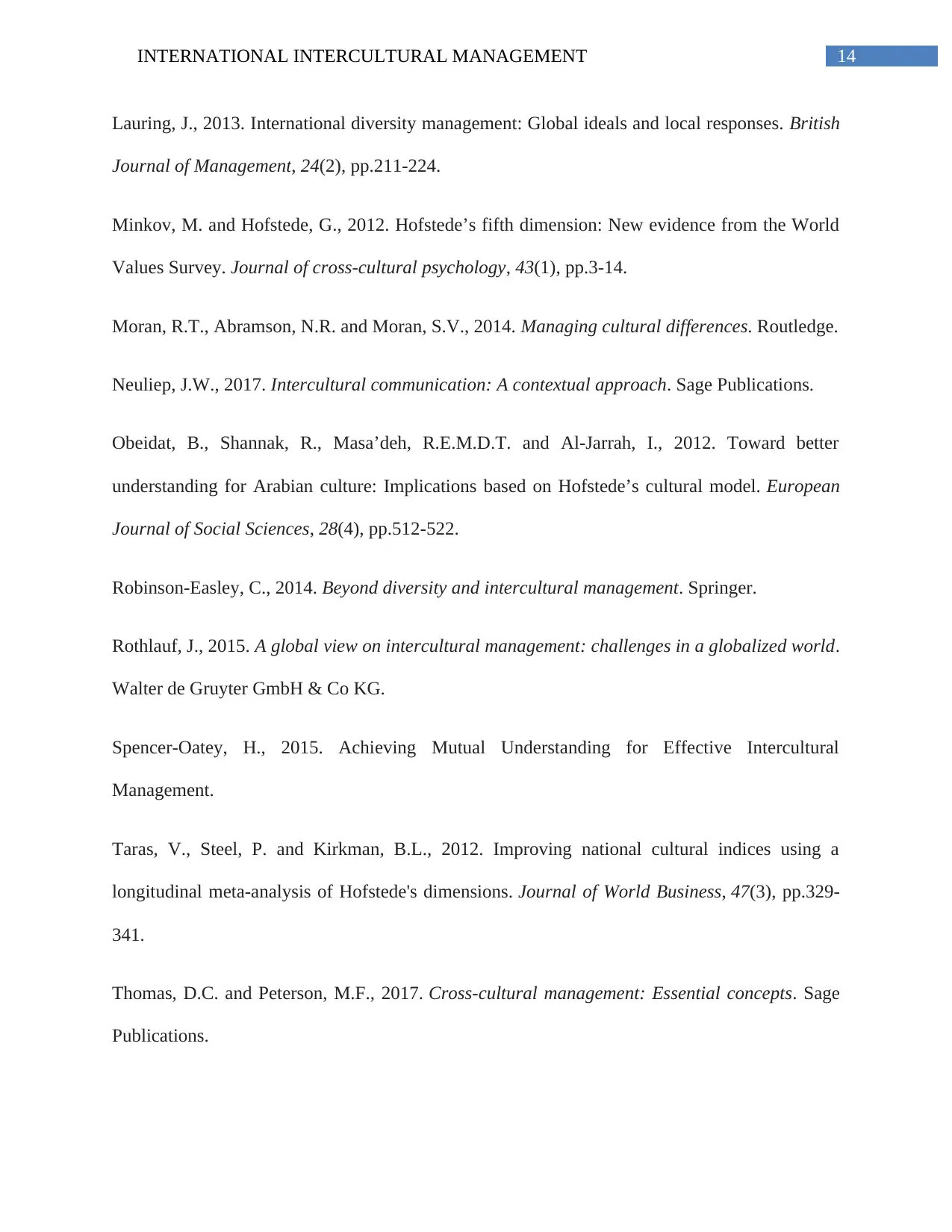
14INTERNATIONAL INTERCULTURAL MANAGEMENT
Lauring, J., 2013. International diversity management: Global ideals and local responses. British
Journal of Management, 24(2), pp.211-224.
Minkov, M. and Hofstede, G., 2012. Hofstede’s fifth dimension: New evidence from the World
Values Survey. Journal of cross-cultural psychology, 43(1), pp.3-14.
Moran, R.T., Abramson, N.R. and Moran, S.V., 2014. Managing cultural differences. Routledge.
Neuliep, J.W., 2017. Intercultural communication: A contextual approach. Sage Publications.
Obeidat, B., Shannak, R., Masa’deh, R.E.M.D.T. and Al-Jarrah, I., 2012. Toward better
understanding for Arabian culture: Implications based on Hofstede’s cultural model. European
Journal of Social Sciences, 28(4), pp.512-522.
Robinson-Easley, C., 2014. Beyond diversity and intercultural management. Springer.
Rothlauf, J., 2015. A global view on intercultural management: challenges in a globalized world.
Walter de Gruyter GmbH & Co KG.
Spencer-Oatey, H., 2015. Achieving Mutual Understanding for Effective Intercultural
Management.
Taras, V., Steel, P. and Kirkman, B.L., 2012. Improving national cultural indices using a
longitudinal meta-analysis of Hofstede's dimensions. Journal of World Business, 47(3), pp.329-
341.
Thomas, D.C. and Peterson, M.F., 2017. Cross-cultural management: Essential concepts. Sage
Publications.
Lauring, J., 2013. International diversity management: Global ideals and local responses. British
Journal of Management, 24(2), pp.211-224.
Minkov, M. and Hofstede, G., 2012. Hofstede’s fifth dimension: New evidence from the World
Values Survey. Journal of cross-cultural psychology, 43(1), pp.3-14.
Moran, R.T., Abramson, N.R. and Moran, S.V., 2014. Managing cultural differences. Routledge.
Neuliep, J.W., 2017. Intercultural communication: A contextual approach. Sage Publications.
Obeidat, B., Shannak, R., Masa’deh, R.E.M.D.T. and Al-Jarrah, I., 2012. Toward better
understanding for Arabian culture: Implications based on Hofstede’s cultural model. European
Journal of Social Sciences, 28(4), pp.512-522.
Robinson-Easley, C., 2014. Beyond diversity and intercultural management. Springer.
Rothlauf, J., 2015. A global view on intercultural management: challenges in a globalized world.
Walter de Gruyter GmbH & Co KG.
Spencer-Oatey, H., 2015. Achieving Mutual Understanding for Effective Intercultural
Management.
Taras, V., Steel, P. and Kirkman, B.L., 2012. Improving national cultural indices using a
longitudinal meta-analysis of Hofstede's dimensions. Journal of World Business, 47(3), pp.329-
341.
Thomas, D.C. and Peterson, M.F., 2017. Cross-cultural management: Essential concepts. Sage
Publications.

15INTERNATIONAL INTERCULTURAL MANAGEMENT
1 out of 16
Related Documents
Your All-in-One AI-Powered Toolkit for Academic Success.
+13062052269
info@desklib.com
Available 24*7 on WhatsApp / Email
![[object Object]](/_next/static/media/star-bottom.7253800d.svg)
Unlock your academic potential
© 2024 | Zucol Services PVT LTD | All rights reserved.





